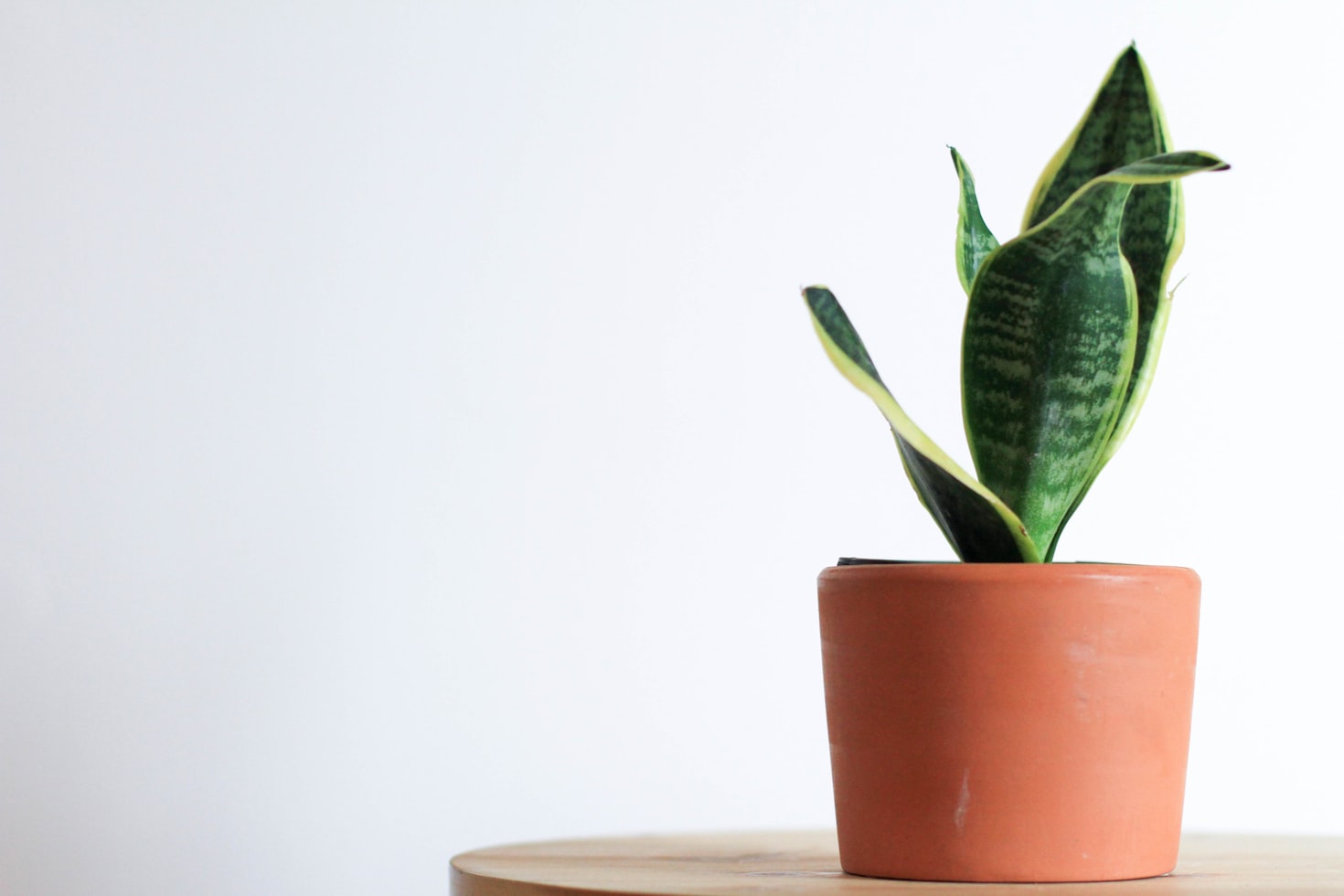Arriving at the office before the sun rises and leaving at dusk can cause a real sense of deprivation for those who love the outdoors. Using a light therapy lamp or lightbox can help, but adding some houseplants might be the missing nature link needed to improve productivity and satisfaction on the job. Office plants can increase the humidity around a desk, purify the air,1 and add to your workspace decor.
1. Snake Plant
The tough nature of Sansevieria, also known as the snake plant or mother-in-law’s tongue, means that it might continue to grow until its owner retires. Not all snake plants are created equal when it comes to size. Read the plant label carefully to avoid choosing a cultivar that grows several feet high. Instead, look for a dwarf selection like ‘Futura Superba’ or ‘Whitney.’ Perfect for houseplant newbies, snake plants require little special attention—give it a drink from your water bottle on it on your way out the door on Friday and enjoy this slow-growing desk plant.
2. African Violet

The fuzzy-leafed plant popular in the 1970s still has a cult following and for good reason: modern African violet hybrids thrive in the same conditions as humans do, with average humidity and temperatures. Although sufficient light is necessary for blooms, African violets aren’t picky about the source of that light, and a fluorescent lamp aimed at the plant is acceptable. A window that faces north or east provides ideal light conditions; avoid placing this plant in direct sunlight. Miniature violets, less than six inches in diameter, mean that even the smallest spaces can accommodate a flowering office plant.
3. English Ivy

Soften the hard lines of a desk with a trailing plant like English ivy. Ivy requires medium light and average water to thrive indoors. If the trailing climbing nature of ivy gets too exuberant, wrap ivy tendrils around a trellis or wire obelisk for a living piece of art.
Although you can’t go wrong with any variety of the classic Hedera helix, newer cultivars have added more diversity. ‘Silver Dollar’ and ‘Yellow Ripple’ feature grey or gold variegation. Small spaces benefit from dwarf varieties like ‘Pixie Dixie.’ For those who crave fancy foliage, try the ruffled leaves of ‘Curly Locks’ or ‘Manda’s Crested.’
4. ZZ Plant

Zamioculus zamifolia, commonly known as the ZZ plant, is a succulent with two characteristics that have rocketed it in popularity as a houseplant: tolerance to low light and the ability to grow with little water. The ZZ plant is native to Africa and will do just fine with fluorescent bulbs as its only light source. The laddered leaves of the common ZZ plant are a pleasing addition to the office setting, but the nearly black stems and foliage of the latest ‘Raven’ cultivar look stunning against a white desktop.
5. Aloe

Aloe plants are easy to grow if they are supplied with one essential ingredient: lots of bright light. If a desk is located near a sunny window, place the plant there, and forget about it, because these succulents only need watering every couple of weeks. The standard Aloe barbadensis is attractive enough for any modern office space, or you can explore the merits of the dwarf ‘Minibelle’ or the speckled ‘Tiger Tooth’ cultivar that only looks like it has sharp teeth. Grow them in a sandy cactus mix to ensure the excellent drainage these plants require.
6. Philodendron

Whether an office is flooded with natural light or is tucked in a cozy corner, the carefree philodendron will add cheer with its glossy green leaves and trailing habit. Although the philodendron is often used for hanging baskets, it works just as well growing up a small trellis or totem pole. The philodendron requires regular moisture to keep its lush look, so a self-watering pot will be a lifesaver for those specimens without a consistent caregiver. For a handsome container combination, grow the silvery mottled ‘Brandi’ cultivar along with a standard green variety like ‘Green Heartleaf.’
7. Tillandsia

To grow Tillandsia or any plants that don’t require soil (known as air plants), it’s necessary to think outside the pot. You can affix air plants to a piece of driftwood with some fishing line. You can also fill a miniature terrarium with air plant varieties or arrange air plants in a shell, teacup, or another unconventional container.
The Tillandsia genus includes several hundred species in the bromeliad family, all with green, silver, or rosy spiked foliage. As epiphytes that are accustomed to growing among shady tree branches, air plants don’t need much light, but those on sunnier desks are more likely to grow a flower spike. Mist the entire plant weekly because the modified scales on the leaves will absorb the moisture the plant requires.
8. Lucky Bamboo

The common name lucky bamboo isn’t actually one of the more than one hundred genera of true bamboo. Rather, Dracaena sanderiana is related to the corn plant, another easy-to-grow houseplant. Growers sometimes shape lucky bamboo stems into fun shapes like spirals, weaves, or even hearts. Left to their own devices, the stems of lucky bamboo will eventually outgrow their trained shapes, but plants grow slowly. Lucky bamboo grows well in low-light environments and can grow without soil when the stems are submerged in water. However, make sure the water level doesn’t sink below the stems or the plant might not recover from this desiccation.2


